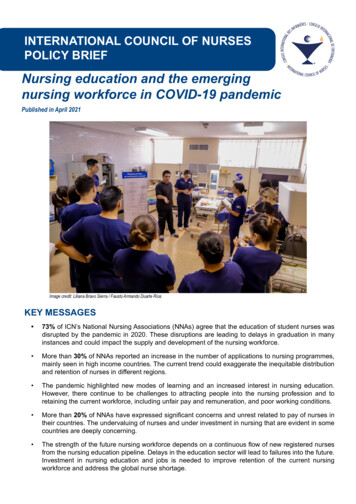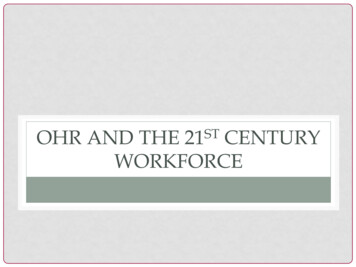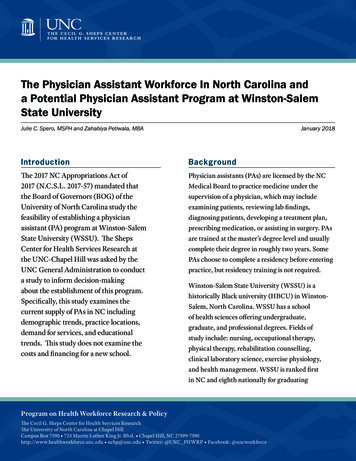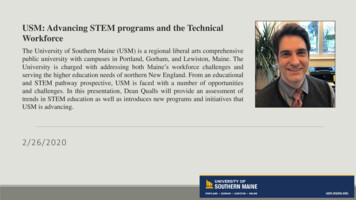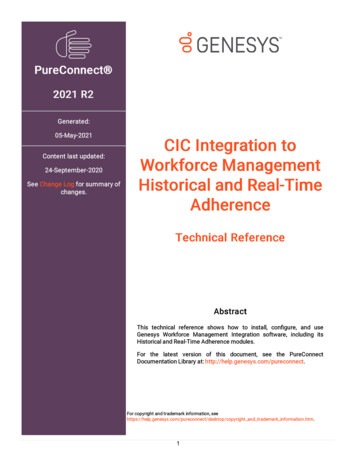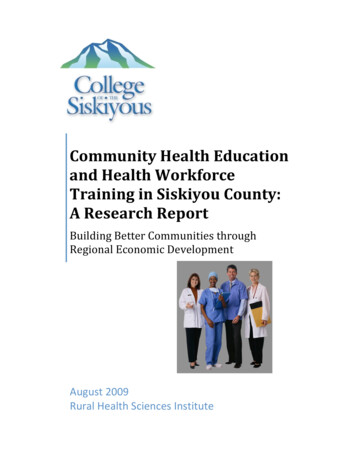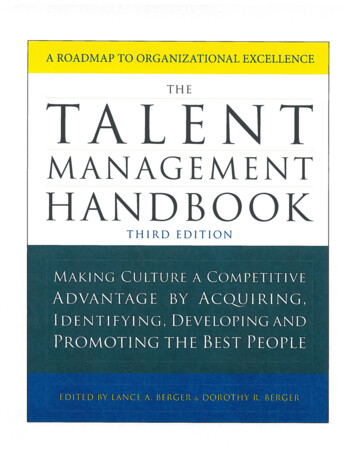
Transcription
A ROADMAP TO ORGANIZATIONAL EXCELLENCETHETALENTMANAGEMENTHANDBOOKTHIRD EDITiONMAKING CULTURE A CoMPETITIvEADVANTAGE By AcQVIRING,IDENTIFYING, DEVELOPING ANDPROMOTING THE BEST PEOPLEEDITED BY LANCE A. BERGER&DOROTHY R. BERGER
Chapter 46The Internal Labor MarketParadigm: A Model for UsingAnalytics to Evaluate andInterpret Workforce andBusiness Performance DataHaig R. Nalbantian, Senior PartnerMercer Workforce Sciences InstituteMANY ORGANIZATIONS SAY THAT THEIR WORKFORCE IS AN ASSET—EVEN THEIRgreatest asset. How many manage their workforce as if it were an asset? Howmany can point to specific methods and processes they use to gauge the payoff fromtheir workforce decisions and expenditures that remotely match the disciplined, quantitative rigor they routinely bring to decisions about financial and physical assets? Theanswer is very few. Workforce decisions are still made primarily on the basis of industry benchmarks, “best practice” comparisons, management philosophy, employee andmarket surveys, or simple gut feel. In no other area of business management or investment choice are decisions involving such large sums of money made on such a flimsy,noneconomic basis.This state of aflairs is surprising in light of the current “big data” and analytics revolution that is transforming the way decisions are made in almost every business functionand across many fields. The proliferation of easily accessible, digital data on customers, workers, investors, and companies has made it easier for organizations to practiceevidence-based decision making. This discipline enables them to target their investmentsto high-yield areas. While it has been relatively slow to adapt, the human resources (HR)function is also embracing analytics and big data. In recent years, workforce analytics54246Bergerindd 542C01/11/17 1:10PM
The Internal Labor Market Paradigm543has emerged as a burgeoning domain within HR There has been a surge in the numberof businesses establishing in-house workforce analytics functions. The infusion of datascientists and empirically oriented HR practitioners is helping HR become a more quantitative discipline and helping HR leaders uncover opportunities for improving workforce management.The type of analytics being conducted is evolving quickly as well. HR professionalsand line managers in the vanguard of workforce analytics are shifting emphasis fromreporting of basic descriptive workforce data—for example, workforce demographics,rates of employee turnover, distributions of performance ratings—to delivering resultsfrom “predictive” models designed to forecast the likely effects of specific workforcepractices. for example, recruiters are increasingly turning to predictive models to identify better job candidates and improve the quality of hires. Some organizations are usingpredictive models to estimate the “flight risk” of their employees, enabling managersto intervene to preempt unwanted turnover among their direct reports. By deliveringthis kind of output, workforce analytics teams are having an impact on HR. But are theyhaving a similar impact on the business?Despite these notable advances, building a workforce analytics capability thatdelivers true workforce intelligence remains a challenge to even the most sophisticated of HR departments. More than ever before, leaders and managers have accessto volumes of workforce and performance data, but true insight remains elusive.Workforce analysts struggle to uncover the story within the data and communicate itin a way that resonates with executives and motivates them to action. This is a common lament of HR leaders. As a result, the output of workforce analytics has failedgenerally to infiltrate the executive suite and seed an authentic asset managementview of human capital among top executives. This limits the impact that workforceanalytics can have on the business.in my roughly 25 years of delivering results of advanced analytics to organizationsand advising them on their workforce strategies and investments, I have come to believethat while data are the foundation of good workforce analytics and technology essentialto facilitate the extraction and delivery of analytical output, they are not what drive itsultimate business value. Rather, the discipline’s success depends on the analytical lensprofessionals use to examine the data—a lens that can be crafted with insight from relevant fields such as labor economics, organizational psychology, and other social sciences.The shift from workforce data to strategically valuable workforce intelligence will notcome from new algorithms or ever-more granular data collection alone, though these areworthy undertakings—but from deploying a strong framework, or perspective, on howto synthesize and interpret findings from the data analysis.The Internal Labor Market LensSince the early 1990s my colleagues and I at Mercer have relied on the construct ofthe internal labor market (ILM) as the basis of the lens we use to analyze and interpretworkforce and business performance data. The classic idea of an internal labor market46 BergerJndd 54301/11/171:10 PM
Part VI. Big Data544invokes a particular set of workforce practices and processes that actually supplantexternal labor market forces in allocating and pricing labor (Peter B. Doeringer andMichael J. Piore, 1971). In its more modern incarnation, articulated in Nalbantian andcolleagues (2004), the idea has been vastly broadened to comprise the entire rangeof management practices that govern how talent is recruited, selected, developed,evaluated, rewarded, managed, retained, or terminated. The approach is based on theobservation that an organization’s workforce, the workforce it has today and the one itwill have in the future, is the outcome of a set of talent “flows”—enfry, exit, development (i.e., promotion, lateral moves, and learning)—and the system of rewards offeredby the organization which values employees both for what they bring and what theydo. These talent flows and rewards—what we call “ILM dynamics”—are influenced bypolicy choices and by external labor market conditions. The talent flows and rewardsinteract to create the human capital of the firm and determine how well the workforceperforms. Organizations that understand these ILM dynamics are better positioned toshape their workforce to their business needs.Mapping the Internal Labor MarketAn internal labor market (ILM) map is a well-established way to render an organization’s talent dynamics. As displayed in figure 46.1, the map represents the distribution of employees across career levels and the average annual rates of movementinto (i.e., new hires), out of (i.e., turnover), and through (e.g., promotions, lateralmoves) these levels over the period analyzed, usually, three to five years.HiresLevel otion5/LateralMovesFigure 46.1 Internal Labor Market Map: Representative Example4&Bergorindd54401/11117 110PM
The Internal Labor Market Paradigm545The ILM map offers a “system-at-a-glance” view of the dynamic process that actually creates an organization’s workforce. ILM maps across and even within organizafions can differ in shape, size, relathre orientation of “buying” versus “building”talent, overall velocity of talent movement, the degree and location of career bottlenecks or choke points, concentration of hiring and/ar exits at particular levels,among other things. Observations on these descriptive characteristics can be veryrevealing about critical human capital issues. Even more powerful is informationlearned from statistically modeling the drivers of these talent flows and associatedrewards to explain why the internal labor market functions as it does and whichworkforce characteristics and piactices are most mfluentril in drn mg observedoutcomes. See Nalbantian, Guzzo, et aL (2004).Mapping an Internal Labor MarketILM Analysis is a way of quantifying and explaining internal labor market dynamics.(for more information on ILM analysis, see Nalbantian and colleagues 2004). The methodology involves a coherent set of models designed to statistically estimate and quantifythe drivers of the key workforce dynamics of retention, promotion, performance, and pay.Using this particular lens, organizations can uncover and articulate the story within thedata, one that captures the unique opportunities and looming risks related to workforcemanagement. By quantifying key relationships, they can objectively prioritize the actionsmost likely to help them seize those opportunities and mitigate those risks more effectively. finally, the ILM lens brings an unambiguously economic view of human capitalmanagement, providing the basis to treat workforce decisions as investment decisions.The Language of MarketsPerhaps the most consequential benefit of the ILM approach is that i.t uses a languagethat executives inherently understand—the language of markets. Executives are all aboutmarkets. Identifying, understanding, anticipating, and responding to the various marketswith which their business interacts—customer markets, capital markets, supplier markets,and external labor markets—is what they do. Executives are constantly working to get ahandle on market developments to uncover opportunities to make money. They are constantly seeking advantage over competitors who are engaged with those same markets.That’s their prime responsibility. Somehow executives have had a blind spot for internallabor markets. This is ironic as the internal labor market is the only market over whichthey have meaningful control, unless, of course, their organizations are monopolies.Part of the problem is that executives may not recognize that they are running aform of labor market. The ILM is very much a market. It performs all of the core functions of more traditional “external” labor markets: matching people to jobs, motivating people to perform in those jobs, and pricing those jobs, along with the attributes,capabilities, and behaviors people apply at work. The only difference is that the thMaccomplishes these functions through internal processes and procedures rather thanthrough arm’s length transactions.46Bergerindd01/11/17 1:10PM
Part VI. Big Data546Demand and SupplyLike all markets, the ILM is driven by the dynamics of demand and supply. Thedemand side of the ILM is a derived demand. It reflects the attributes, capabilities,and behaviors that are needed in and from the organization’s workforce to achieveits business goals. These can be determined using qualitative methods such as structured surveys or interviews that elicit the expert opinions of those closest to thebusiness as to what those workforce requirements are or will be. But they can alsobe determined through the application of advanced workiorce modeling. Carefulstatistical analysis of the running record of business performance can be used to linkworkforce attributes and management practices to actual business outcomes. Theidea is to uncover from the organization’s performance history the real sources ofhuman capital value to the firm.This professional services firm, for example, used statistical modeling to identifyand measure how the composition of sales and delivery teams influenced year-to-yearsales growth with respect to their large national clients. Figure 46.2 provides severaldrivers for revenue growth at a professional services firm.The evidence showed that all else being equal, greater staffing diversity on theseteams—whether it be diversity of disciplines or business practices, diversity ofexperience as measured by variation in tenure, or even demographic diversity—ledPercentage 7-year growth in revenue0%Breadth of relationshipDelivering one additional service to customersStability of relationshipsIncrease in dedicated staff serving customers(from 15%to3O%)A 33 /o reduction in the turnover of the mostseasoned peopleA 33% reduction in voluntary turnover5%10%15%20%——Key personal attributesAn increase from 5 to 7 years in the average tenureAn 8% increase in the average performancerating of employeesDiversityA 33% increase in the range of tenure of customerservice employeesAn increase in the percent of nonwhites (fromlOtolS%)Figure 46.2 Selected Workforce Drivers of Revenue Growth at Professional CompanyI46 Bergerindd 54601/11/17 1:10PM
The Internal Labor Market Paradigm547to significantly higher sales growth. For instance, teams with higher average tenureamong their members far outperformed those with members with average tenure.But those effects were magnified when the most tenured employees were matchedwith new blood. The results of such modeling effectively provide the basis for aworkforce blueprint for sales and delivery teams, outlining an optimal configuration of workforce attributes and behaviors that define the demand side of the company’s ILM.The supply side of the ILM reflects the current and evolving mix of workforce capabifities that reside in the organization or to which the organization has access. Theseare driven by talent flows noted earlier; how well the organization is able to attract,select, and retain the kind of talent required for business success; how effectively theorganization develops this talent both through formal training and development andthrough on-the-job learning as employees move through assignments, roles, and careerlevels, among other things; and how well the organization applies this talent to theright ventures and goals and motivates employees to perform at high levels. Simplyhaving the right assets in place is not enough. Inducing talent to perform is a big partof the equation.Just as on the demand side, insight into supply can be derived through qualitativemeans—for example, exit interviews that get at the reasons employees leave the firm,or engagement surveys that help gauge what elements of the employment proposition are most valued by employees or what actually influences the level of productiveengagement b
This state of aflairs is surprising in light of the current “big data” and analytics revo lution that is transforming the way decisions are made in almost every business function and across many fields. The proliferation of easily accessible, digital data on custom ers, workers, investors, and companies has made it easier for organizations to practice evidence-baseddecision making. This .
